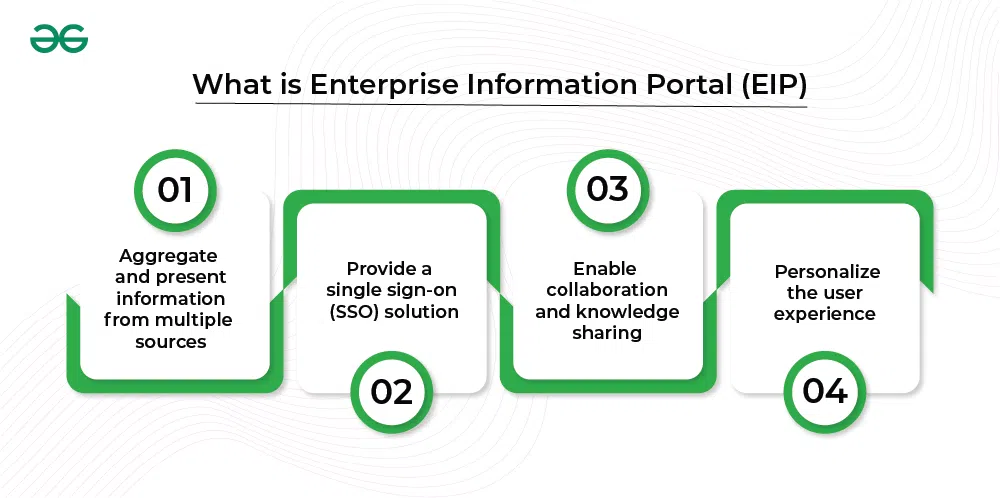Enterprise Information Portal (EIP) in E-Commerce: Meaning, Advantages and Disadvantages
Last Updated :
01 Dec, 2023
A web-based platform known as an enterprise information portal (EIP) gives customers, partners, and staff members a single point of access to data and services.

It may be utilized for:
- Aggregate and present information from multiple sources. Data can be retrieved by an EIP from a variety of systems, including customer relationship management (CRM), enterprise resource planning (ERP), and human resources (HR) systems. It can then display this data in a manner that is simple for consumers to grasp and utilize.
- Provide a single sign-on (SSO) solution. Users may be able to sign in to multiple platforms with a single set of credentials by using an EIP. Users may benefit from the time and hassle savings, and security may also be improved.
- Enable collaboration and knowledge sharing. Users can collaborate and share information on an EIP forum. Both productivity and communication may benefit from this.
- Personalize the user experience. An EIP can be customized to the individual needs of each user. This can help to improve the user experience and make it easier for users to find the information they need.
History of Enterprise Information Portal (EIP)
Enterprise information portals (EIPs) have a long history dating back to the early days of the Internet when businesses started building internal webpages to communicate with their staff. These early websites, however often static and of a limited size, laid the groundwork for the creation of EIPs.
- Midway through the 1990s, as businesses started to realize the benefits of giving employees a single point of access to data from various sources, the first genuine EIPs arose. These EIPs were often constructed on top of already-existing business applications like customer relationship management (CRM) and enterprise resource planning (ERP) systems.
- EIPs started to become widely used in the early 2000s as businesses began to see the advantages of increasing employee collaboration and communication. Customers could now get information about goods and services thanks to the adoption of EIPs.
- EIPs started to become widely used in the early 2000s as businesses began to see the advantages of increasing employee collaboration and communication. Additionally, the usage of EIPs to give customers access to product information
- EIPs have developed over the past few years to address the shifting needs of enterprises. EIPs are now easier to access than ever because of the development of cloud computing and mobile technology. New business procedures like big data analytics and customer journey mapping are supported by them as well.
- Improve communication and collaboration: Employee information plans (EIPs) can offer a venue for communication and information sharing. This may contribute to greater internal communication inside the company and better decision-making.
- Increase employee satisfaction: By giving employees a single point of access to information and services, EIPs can aid in boosting employee satisfaction. Employees may be more productive and feel more appreciated as a result.
- Improve compliance: EIPs give companies access to a centralized information repository, which can help them better comply with regulations. This might make it easier for organizations to monitor and track compliance needs.
- Cost: EIP implementation and maintenance can be costly. For companies with tight finances, this can be a significant obstacle.
- Security risks: Security attacks may target EIPs. This is because they frequently include sensitive data that an attacker could use to access a company’s systems or data.
- Data overload: Users may find EIPs to be overwhelming if they are not properly organized and designed. Due to their frustration, users might not take full use of the EIP as a result.
- Lack of user adoption: If EIPs are poorly designed and difficult to use, consumers may not embrace them widely. Businesses that invest in EIPs may find this to be a significant waste of time and resources.
Here are some tips for minimizing the disadvantages of EIPs:
- Select an EIP solution based on the complexity and size of your company.
- Make sure you have the tools and knowledge necessary to manage and implement the EIP.
- Make sure the EIP is well-organized and user-friendly by carefully planning its design.
- Users should receive instructions on how to use the EIP.
- Keep an eye out for security hazards in the EIP and take action to reduce them.
- You can decrease the drawbacks of EIPs and increase their advantages for your company by paying attention to these pointers.
Share your thoughts in the comments
Please Login to comment...